|
| |
| #8888 |
| 29 |
|
| INT. MEETING ROOM - DAY |
|
| 102 |
Godzilla sits in room alone. A MESSENGER comes
running through the door, skids to his knees, in an excited
manner.
| 102 |
|
|
MESSENGER # 1 (IN JAPANESE) | |
| |
They have captured some
of our men!
| | |
|
|
Godzilla grunts. messenger # 1 runs out. From another
sliding door, in comes MESSENGER # 2.
| |
|
| |
MESSENGER # 2
Many were caught in the tree:
| | |
|
|
Godzilla grunts. He runs out. MESSENGER # 3 runs in.
| |
|
| |
MESSENGER # 3
We are afraid!
| | |
|
|
Godzilla grunts. # 3 runs out.
| |
|
| |
MESSENGER # 4
They are attacking!
| | |
|
|
Godzilla is getting dizzy with the messengers. # 4 exits.
Peter runs in.
| |
|
| |
PETER (IN JAPANESE)
You better watch out!
| | |
|
|
Godzilla grunts.
| |
|
|
PETER (IN ENGLISH TO MAKE HIMSELF
CLEAR)
| |
| |
I said you better watch out!
| | |
|
|
Peter runs out. Godzilla chases after him. Now for the
remainder of the sequence, there is a chase in and out of
the house, through corridors, through paper doors, through
geisha and bath, and 100 sight gags in parody of Japanese
battle sequence. All the weapons are used. At the end,
Godzilla is killed when he squares off in a battle against
Davy, almost winning, laughing at his victim, and then
replacing his sword in its scabbard with the flourish we have
come to love and respect. Only this time, much to his surprise,
he misses the scabbard and impales himself. As Davy
receives congratulations from the other Monkees, we:
| |
|
| CUT TO: | | |
|
| INT. MEETING ROOM - DAY |
|
| 103 |
Papa and Toshiko sit in gratitude before the Monkees.
| 103 |
| | |
| |
| #8888 |
CHANGES
Revised Page
January 24, 1968 |
| 30 |
|
| 104 |
CU TELEVISION SET
Pull back from this scene (matte) as a hand reaches into
the frame and turns the channel to:
| 104 |
|
| CUT TO: | | |
|
| 105 |
STOCK SHOT - A POLE VAULTER
| 105 |
|
| CUT TO: | | |
|
| 106 |
STOCK SHOT - A NEWS BROADCAST
| 106 |
|
| |
ANNOUNCER
Students at San Francisco State
today compelled by force through
representatives of the...
| | |
|
|
Hand changes the station
| |
|
| CUT TO: | | |
|
| EXT. DESERT - DAY |
|
| 107 |
Micky, wandering through the desert. We can't see
his face; the sun backlights him. He stumbles. Change
stations.
| 107 |
|
| CUT TO: | |
| | |
And, with a click, we're suddenly firmly back in Head territory. Full ponderings on the 'Godzilla' sequence coming up, but first let's get the channel-hopping out of the way.
As mentioned, since 'Godzilla' wasn't filmed, Head uses the TV channel hopping device to cut from the close of 'Circle Sky' instead. This is executed in a simpler manner than the script calls for. We don't 'pull back' from the TV set, although some of the selections chosen are framed around the edges with a matte overlay of a TV outline. The channel-changing hand (later revealed to belong to Victor Mature as 'The Big Victor') never enters the same shot as the TV screen and is instead presented as a cutaway - with a remote control.
| | "Sounds like a lotta supernatural baloney to me..." | |
The manner in which 'Godzilla' is suddenly interrupted by the channel hopping at the start of the 'Revised' Page 30 would naturally lead one to assume that earlier drafts allowed the scene to continue further, unmolested. However, the next two pages - which aren't marked as 'Revised' or 'Added' - also feature the TV channel device, plus slight returns to the Japan set-up. We must therefore conclude that December 19 first-draft of 'Changes' always intended for 'Godzilla' to be cut off towards the end, and any revisions made to Page 30 were purely in terms of the 'choice of viewing'!
| |
| #8888 |
| 31 |
|
| 108 |
STOCK SHOT - A WALKING RACE
| 108 |
|
|
Change stations
| |
|
| CUT TO: | | |
|
| 109 |
RALPH WILLIAMS FORD COMMERCIAL
| 109 |
|
| |
RALPH
The largest Ford dealership
in the western hemisphere...
| | |
|
|
Change stations
| |
|
| CUT TO: | | |
|
| INT. MEETING ROOM - DAY |
|
| 110 |
| 110 |
|
| |
PAPA (IN JAPANESE)
So again, my humble thanks. As
for my daughter, she has humbly
requested...
PETER
(translates)
So again, my humble thanks. As
for my daughter, she has humbly
requested....
MIKE
(softly to Micky)
...that all four of us remain forever in Japan until such time as
Davy yields his body and soul to
the tranquillity and bliss of
oriental existance.
| | |
|
|
Change stations.
| |
|
| CUT TO: | | |
|
| 111 |
STOCK SHOT - NEWSREEL FOOTAGE - SOUTH VIET NAM
| 111 |
|
| |
ANNOUNCER (V.O.)
Government officials now put
the casualty total at...
| | |
|
| CUT TO: | | |
|
| 112 |
A CARTOON - STOCK SHOT
Bullwinkle does a spin, lands in a crash, LAUGH TRACK
| 112 |
|
| CUT TO: | |
| | |
These pre-scripted channel-hopping examples would presumably only ever have been intended as a rough guide to what we saw in the movie, given that they'd planned to use snippets of actual TV broadcasts. Having said that, the writers do appear to have had a particular Rocky & Bullwinkle cartoon in mind. In Head, no Bullwinkle pratfalls appear however, and the only cartoon clip chosen features towards the end of the movie - in a reprise of the channel-hopping scene.
In addition to the Vietnam news-reports, the ubiquitous Ralph Williams Ford Dealership commercials and other random TV clips, Head also features some quite lengthy clips of classic films during the channel-hopping. The cutting together of these images via the click of a remote control allowing the film-makers to make the disparate characters seemingly interact with or comment on each other (a prime example being the news footage of (then Governor of California) Ronald Reagan's tough-guy news stance followed by the movie dialogue "Sounds like a lotta supernatural baloney to me..."). Ironically, while assembling the soundtrack LP, Jack Nicholson would do similar things with Head's own movie dialogue.
A full breakdown of the source material used for the sequence follows:
|
| 1. |
"I gave her a very powerful narcotic. I'm sure it will be effective soon..."
The first of two clips featuring Bela Legosi in the Universal Pictures film The Black Cat (1934).
Note that no TV effects accompany the changes from the post-concert footage to this scene. We simply hear a click on the soundtrack. | |
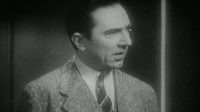 | | | |
|
| 2. |
Cutaway of 'The Big Victor' changing channels.
| |
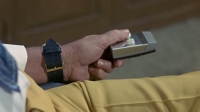 | | | |
|
| 3. |
"Barbara Stanwyck may be in for a slight shock. Her son, Anthony Dion Fay just sold a provocative story about his relationship with Barbara..."
Famed TV gossip columnist Rona Barrett, probably from a broadcast for Los Angeles TV station KABC-TV, although her Hollywood gossip reports tended to be syndicated around the country.
The degraded, scratched quality of the celluloid suggests that, unlike other clips from the sequence, it wasn't filmed off-monitor specifically for Head but is most likely a reel of celluloid intended for syndication (before the advent of affordable VT, film was still the preferred format for sending copies of TV shows to regional stations).
Barbara Stanwyck starred in the Columbia Pictures film Golden Boy (1939) - a film about a violinist who decides to become a professional boxer (a scenario which which is later sent up in Head).
This is the first clip in Head which features the static matte graphic of a TV set overlaid around the main visuals. | |
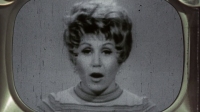 | | | |
|
| 4. |
"Hiah, friends, Ralph here, owner of one of the largest Ford dealerships..."
Genuine clip from a Ralph Williams Ford car ad. Ralph Williams' ads were a mainstay of late-night 1960s Los Angeles television and soon became regarded as a running joke - with archetypal 'used car salesman' Williams representing everything that was shoddy about American industry. Amusingly, a great bit of between-takes studio banter during the Monkees recording sessions in early 1968 (later released on Rhino's Headquarters Sessions set) sees producer Chip Douglas offering up an pisstake of this ad campaign over the talkback with "Hiah, folks, Ralph Williams, president of RCA Victor Records..."
Three further Ralph Williams clips occur during this channel-hopping sequence. However, as per the Rona Barrett clip which preceded it, this first one also appears to have been spliced in from extant celluloid (whereas the others look like they've been filmed offscreen especially for the project). This clip is also framed by the 'television' matte graphic.
All four clips used in the film favour the "world's largest Ford dealer" by-line - as did Shot 109 of the original scripted version.
| | 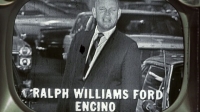 | | | |
|
| 5. |
The plastic dummy Monkees still being torn to pieces from the close of 'Circle Sky'
Degraded quality to make it more like a TV picture, achieved by... filming an actual TV picture, with plenty of blurred frames perfectly highlighting the discrepancies between a television picture refresh rate and a film camera capturing images at 24fps.
Another clip framed by the 'television' matte graphic.
As per the original 'Changes' script, the channel-hopping sequence in Head functions as a transition, including images from the previous scene and the scene which follows it. | |
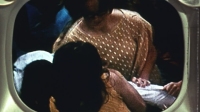 | | | |
|
| 6. |
Your majesty, he acknowledges a king higher than you..." / "But you are the Messiah..."
Lines spoken by Arnold Moss as 'Micha the Queen's Advisor' and Charles Laughton as 'King Herod' respectively, from the Columbia Pictures film Salome (1953). Although culled from the same scene - in which John the Baptist is put on trial for treason - the two lines don't actually follow on from each other in their original context. In fact, Laughton's line comes first. The original film was also in colour, but presented in Head as dirty monochrome.
Salome also features Rita Hayworth's infamous Dance of the Seven Veils (during which she busts moves which wouldn't look entirely out of place in the 'Can You Dig It' sequence of Head). Hayworth will feature in several clips during the second channel-hopping' scene towards the end of the film, although these will be from another Columbia Pictures film, Gilda (1946).
Those wondering whether there were any criteria for choosing of these clips beyond them being favourites of Bob Rafelson may wish to take into account the fact that Arnold Moss had actually appeared in the Monkees episode 'Everywhere A Sheik Sheik' (NBC, tx: September 25 1967), playing 'Vidaru', a devious Arab villain. The episode also features William Bagdad (who plays the 'Black Sheik' in Head).
| |
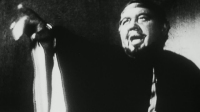 | | | |
|
| 7. |
"Our ship better be sailing out of that harbor on its way home within twenty four hours or we're coming in after it...."
Governor of California Ronald Reagan being interviewed for TV from the back seat of a car.
No further info on this presently.
| |
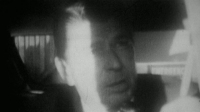 | | | |
|
| 8. |
"Sounds like a lotta supernatural baloney to me..." / "Supernatural, perhaps... baloney, perhaps not..."
A second clip from The Black Cat. Dialogue from David Manners and Bela Legosi respectively. Boris Karloff remains quiet. There's a very slight edit in the middle of the clip, disguised by TV interference although no dialogue is cut. The exchange will be further tightened up when Jack Nicholson uses it as a standalone track on the Head soundtrack LP called 'Superstitious'. Nicholson will also 'remix' it for stereo, putting Manners' line almost exclusively in the left channel and Legosi in the right.
| |
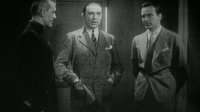 | | | |
|
| 9. |
Micky tumbling down a sand dune.
The first bridge to the next main scene - and, like the snippet of the close of 'Circle Sky', rendered off-monitor TV quality.
Note: in all other editions of Head this shot is in colour. The Criterion Blu-ray however seems to have erroneously reduced it to black and white. Although, having said that, it would have made sense to have done this back in 1968 since it emphasises the gradual change from black and white TV to the next big sequence.
| |
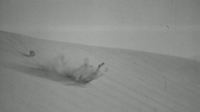 | | | |
|
| 10. |
"I don't read papers, I don't listen to the radio and I haven't seen a television in years..."
Interview with some young, drawling hippie. Source unknown.
| |
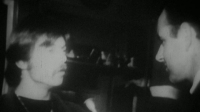 | | | |
|
| 11. |
"You make motion pictures, don't you...?"
From the Columbia Pictures film Jam Session (1944). Ann Miller treats George Eldredge and Eddie Kane to an impromptu audition. As per the second Black Cat clip, a slight tightening up of the scene occurs in the middle, disguised by a TV interference effect, although one word is snipped in the process, and part of the audio is synchronised differently to the source.
| |
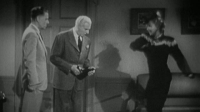 | | | |
|
| 12. |
"What happened?"
Tiny snatch of a TV interview with another young hippie, seemingly from the same source as the earlier clip.
| |
 | | | |
|
| 13. |
"...here at the world's largest Ford dealership, we..."
As previously mentioned, this appears to be part of Rafelson's actual filming session rather than an off-the-shelf ad reel. Note the somewhat lazily-angled picture here in comparison with the earlier clip.
Much has been pondered on various internet fora over the fact that the price-tag reads '666', suggesting some satirical comment on the demonic nature of car-salesmen. It is however unlikely that Rafelson or Nicholson intentionally included this clip to make such a point, the 'number of the beast' only becoming recognised by a mass-media-suckling public with the release of the movie The Omen in 1977. No, the only 'demonic' thing here is the price, right, America? Darn tootin'.
| |
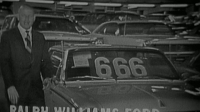 | | | |
|
| 14. |
Micky stumbling over a sand dune with his water bottle.
Another TV-degraded shot, in this case complete with vertical-hold issues.
The actual technicalities involved in getting this effect just right are probably worth considering at this point. Either a proper VT telecine of the necessary footage was arranged, or it was done 'live' with a TV camera relaying images of a film projection while Rafelson simultaneously aimed a movie camera at a monitor and filmed it.
As well as some of the clips mentioned here, footage of Tim Carey as 'Lord High n' Low' hamming it up, and Micky Dolenz blethering on about the nature of the black box would most likely have been 're-processed' during the same session.
| |
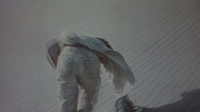 | | | |
|
| 15. |
"...the world's largest Ford dealership..."
Yet more from Filthy Ralph.
| |
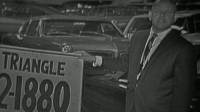 | | | |
|
| 16. |
Micky walks through the desert.
Once again, off-monitor.
| |
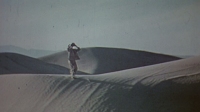 | | | |
|
| 17. |
"...here at the world's largest Ford dealer..."
Not Ralph Williams this time but Chick Lambert, who would do the Ralph Williams commercials when Ralph himself was too busy turning back the clocks on his cars. Lambert's schtick involved having his pet dog accompany him in the ads - although said pet doesn't feature in the snippet chosen.
Gag-reel performances of these ads exist featuring Lambert offering up a slightly more honest take on his TV ad patter, referring to Williams as a "Bald-headed prick" who "came to San Francisco to rape each and every citizen and the San Francisco Bay area..." (while the crew can be heard pissing themselves laughing in the background). Two of these can be found on YouTube here and here.
| |
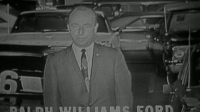 | | | |
|
| 18. |
Cutaway of Big Victor changing channels
A final click from Vic.
| |
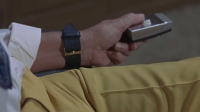 | | | |
|
| 18. |
"My canteen is empty where once it was full..."
Micky walks through the desert. No longer filmed off-monitor, but still framed by the TV matte graphic - which then zooms out.
| |
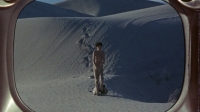 | | | |
A compilation of longer clips of many of the sources used in both channel-hopping sequences can be found here.
With all that in mind, let's go back to the script...
| |
| #8888 |
| 32 |
|
| 113 |
MICKY IN DESERT
| 113 |
|
| CUT TO: | | |
|
| 114 |
HAMMER THROW - STOCK SHOT
| 114 |
|
| CUT TO: | | |
|
| 115 |
BACK TO MICKY
| 115 |
|
| CUT TO: | | |
|
| 116 |
FRAME CUTS
|
1.Cartoon
2. News
3. Ford Commercial |
| 116 |
|
| CUT TO: | | |
|
| EXT. WOODS - DAY |
|
| 117 |
Davy stands saying goodbye to Toshiko. The sun
filters through the setting in what must be the
quintessence of romantic conclusion. Color is off
on the set, and is adjusted.
| 117 |
|
| |
DAVY
(slowly)
I cannot speak your language,
Toshiko. But you must understand...
| | |
|
| 118 |
STOCK SHOT - CARTOON
Bullwinkle tiptoes through a rosegarden
| 118 |
|
| 119 |
FORD COMMERCIAL - STOCK SHOT
| 119 |
|
| EXT. WOODS - DAY |
|
| 120 | |
DAVY
Please don't cry. Just say...
goodbye.
| | 120 |
|
| 121 |
STOCK SHOT - NEWS FOOTAGE
| 121 |
|
| 122 |
BACK TO WOODS
| 122 |
|
| |
TOSHIKO (IN ENGLISH)
...Goodbye...
| |
| | |
"The porpoise is waiting, goodbye, goodbye..."
| |
| #8888 |
CHANGES
Revised Page
January 24, 1968 |
| 33 |
|
| 123 |
STOCK SHOT - TRACK RELAY
The baton pass.
| 123 |
|
| 124 |
BACK TO WOODS
| 124 |
|
| | | | |
|
| 125 |
STOCK SHOT - NEWS FOOTAGE
A man is shot
| 125 |
|
| 126 |
BACK TO WOODS
| 126 |
|
| | | | |
|
| 127 |
CARTOON CREDITS
| 127 |
|
| 128 |
BACK TO WOODS
| 128 |
|
| | | | |
|
| 129 |
FORD COMMERCIAL (PRICE TAG)
| 129 |
|
| |
WILLIAMS (V.O.)
In Ventura...
| | |
|
| EXT. DESERT - DAY |
|
| 130 |
MICKY tries to take a drink from his empty canteen.
He is parched and tosses the canteen disconsolately aside.
| 130 |
|
| |
MICKY (V.O.)
My canteen is empty where
once it was full.
| | |
|
|
He walks irregularly across the dunes.
| |
|
| |
MICKY (V.O.)
(continuing)
My canteen is empty where once
it was full. Empty, empty. Full,
full. My mind seemed incapable
of shaking the torturous thought.
| | |
|
|
He tries to walk on and falls.
| |
| | |
Okay, putting Micky's torturous thoughts to one side for a second, how can we sum up the 'Godzilla' sequence and its place in the production of Head?
In hindsight, it isn't so much a question of why it was cut and more a question of why it ever formed part of the script in the first place. Given that the one unanimous decision reached during the team's brainstorming session in Ojai was that they didn't want to do anything resembling the TV show, why does the longest single scene in the 'Changes' script attempt to do just that? Was it perhaps a bargaining tool, submitted to Columbia Pictures to 'throw them off the scent' while Rafelson and Schneider spent all the money on helicopters, giant vacuum cleaners and exploding Coca Cola machines? Seemingly not...
| 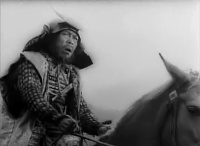 | | | 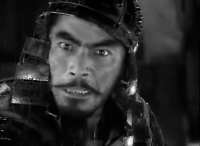 | | | 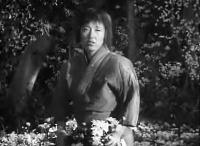 | | | | Shots from Akira Kurosawa's The Seven Samurai (1954) |
| |
The 1976 Sight and Sound interview reveals that Bob Rafelson had been stationed in Japan during his army years and had acquired a job translating Nipponese films into English and advising Shochiku Films on the suitability of movies for export to a US audience. Acquiring a love of Japanese cinema along the way - particularly the works of Ozu and Kurosawa - his credentials for paying tribute to the genre in Head would surely have been second to none. The 'Godzilla' sequence certainly makes more sense thematically if you imagine it in shaky monochrome a la Kurosawa's The Seven Samurai.
In terms of production feasibility, a Monkees tour of the Far East had actually been planned for May 1968 - and this would have coincided with the end of the main film shoot, allowing them to tie in some location filming in Japan. Glenn A. Baker's Monkeemania mentions this in passing, and also reveals that Peter Tork had been taking Japanese language lessons in preparation for the visit/filming. As we can see, this would have come in very handy for his dialogue with 'Toshiko'.
However, the Far East tour ended up being rescheduled. It eventually occurred - as a tour of Australia and Japan - from September to October 1968, by which time Head was up on blocks being edited.
Interestingly, although the script update as of January 24 1968 specifies that the sequence was to be omitted, the NME were still reporting as late as March 30 1968 that some parts of the film might still yet be shot in Japan - although a report in Monkees Monthly that same month insisted that it had been 'canceled as a location'.
A biography of Jack Nicholson by Dennis McDougal, Five Easy Decades, mentions in passing that the Godzilla 'sketch' was dropped because Rafelson's insistence on shooting in Japan proved 'one expense too many.' Although it's probably the case that, aside from the odd bit of scenery filming, there's very little in the sequence which couldn't have been easily recreated on US soil at the Columbia Ranch, it's likely that Rafelson believed that, without the added novelty of actually shooting a Japanese Samurai pastiche in Japan, it wasn't worth the effort.
Divorced from the main script, the 'Godzilla' plot can be appreciated as a mini-episode of the TV series. All the plot clichés of the original show are there - the girl in distress, the love-interest for Davy, the high-concept villain, Micky in drag, the knockabout tomfoolery and something akin to the trademark 'romp' which ended each show. There's a certain skewed, jaded take on the whole set-up in parts, but perhaps no more than was evident during the latter half of their second, final, series - and certainly not barbed enough to act as a viable parody or warrant inclusion in a movie aimed at exposing the whole myth of the Monkee phenomenon. Indeed, placed at this point in the overall script (which has so far thrown up scenes of suicide, war, quasi-LSD-trip imagery and philosophical musings on the group's self-image) it comes across as a sharp step-back.
It's also ridiculously long as a set-piece. Even with copious film-editing they'd have been lucky to get this sub-plot under 10-12 minutes. Had the movie started with this plot and then progressed - via the TV channel-hopping - into odder areas then the length would make perfect sense, with the repeated "Goodbye!"s at the end waving a permanent farewell to the TV trappings. Alternatively it could have been snipped out and presented it as a B-feature, Crimson Permanent Assurance-style!
It's worth noting that none of the scenarios depicted in the sequence return later in the script as a reprise (as per practically every other character / set-up in the story), although earlier drafts of the script may have included such. Had his finest hour not been consigned to the bin, Godzilla and his men may eventually have formed part of the rampaging mob which chased The Monkees off the bridge at the end of the film.
Note also that, aside from his sudden ability to speak and understand Japanese, Peter is still very much portrayed as 'the dummy' - something else which the rest of Head makes a specific point of commenting on and dispelling.
Mike's over-cocky "Okay guys, here's my plan..." gag makes a reappearance later in the script (in a scene which did make it to the movie). So was the latter originally conceived as a back-reference or did they simply believe it was too good a joke to waste - unlike the extraordinary sequence of Groucho Marx-style one-liners Godzilla is subjected to, all of which bit the dust? Well, as the Head theatrical trailer by-line insisted, "They can't be the Marx Brothers - they're too young!"
| | The Monkees - Head - 'Changes' | |
| |
|





















